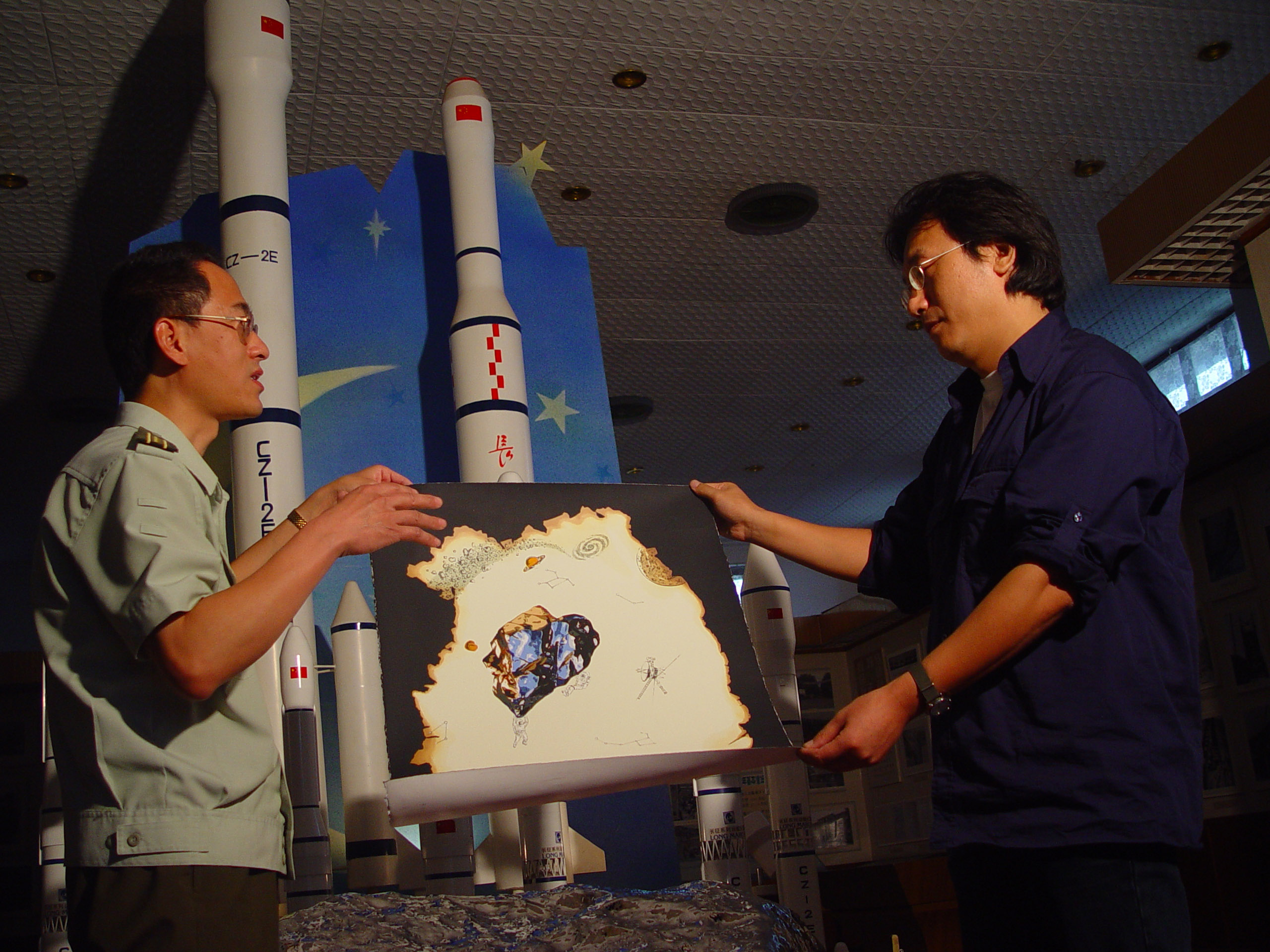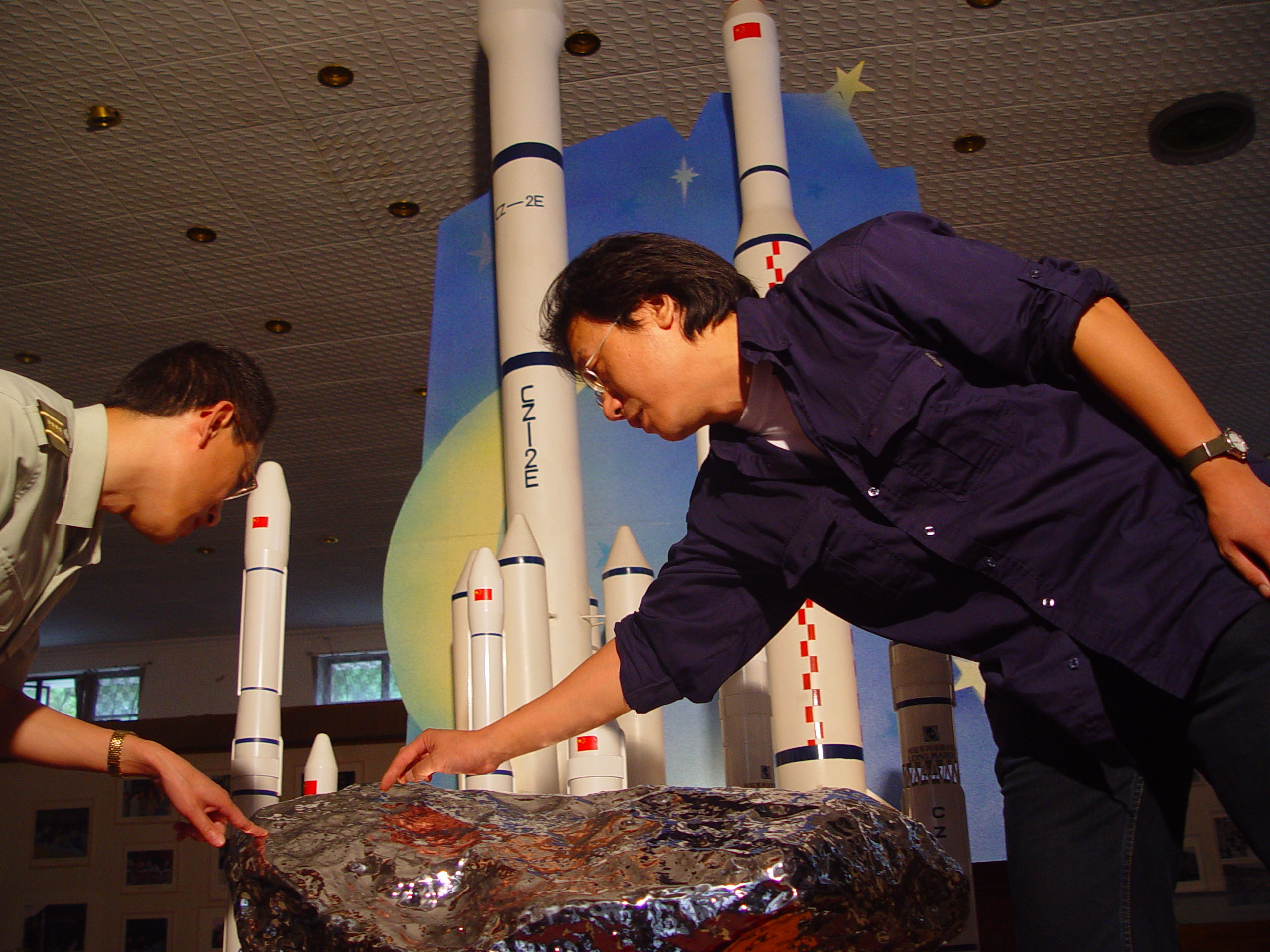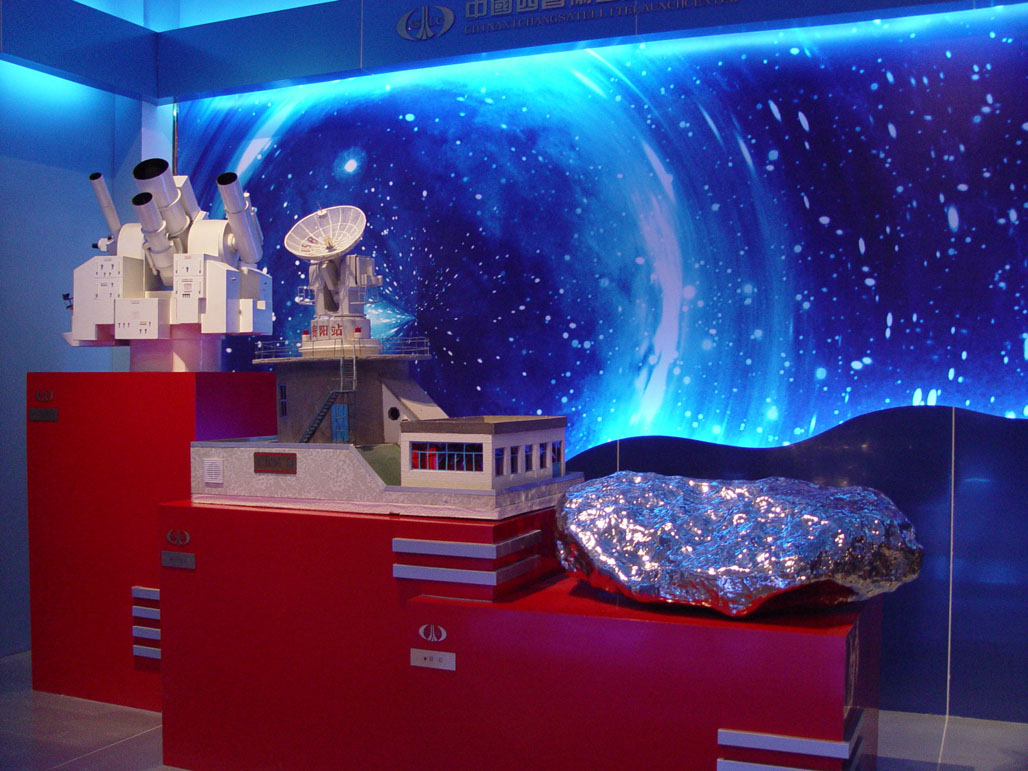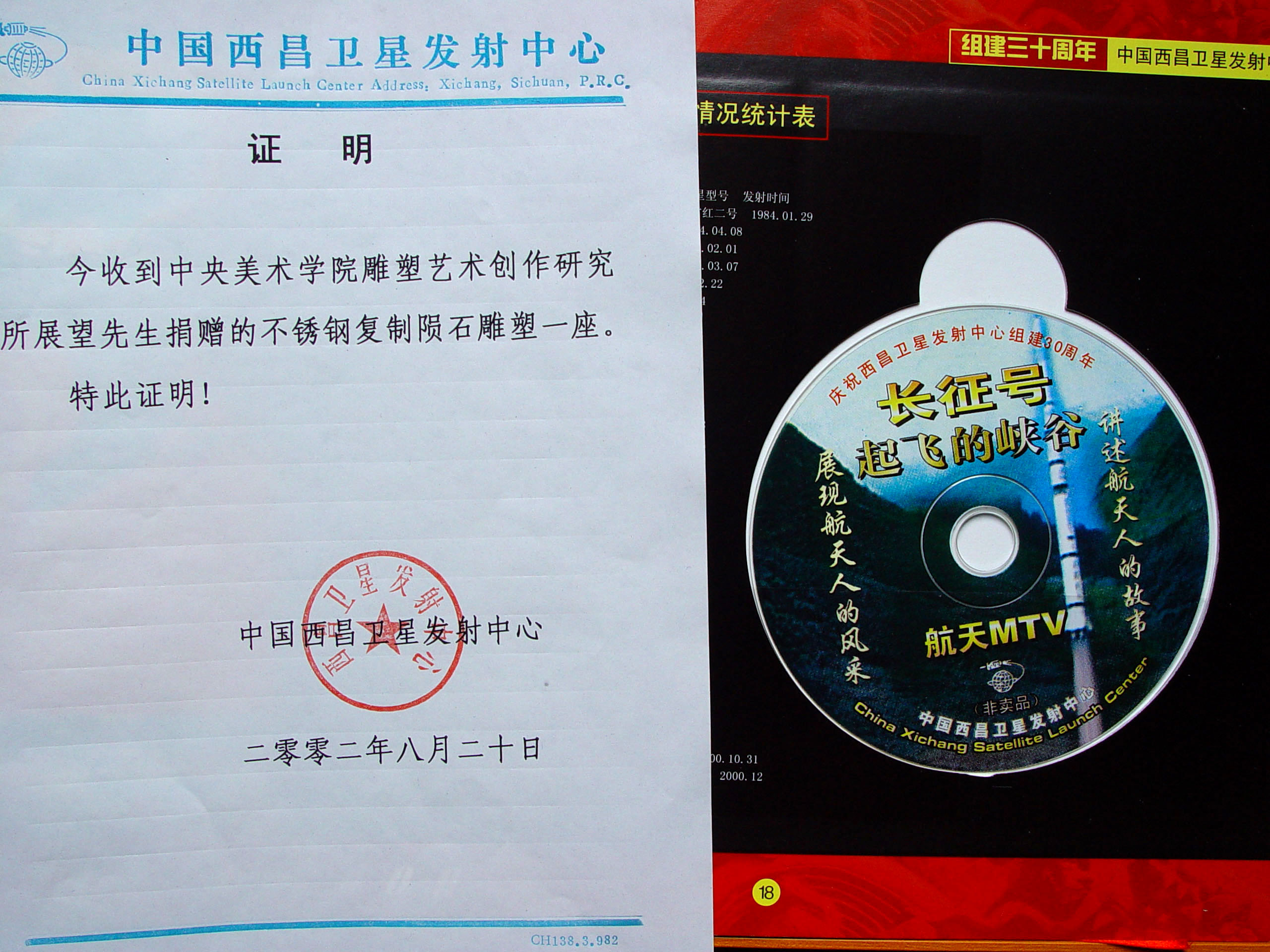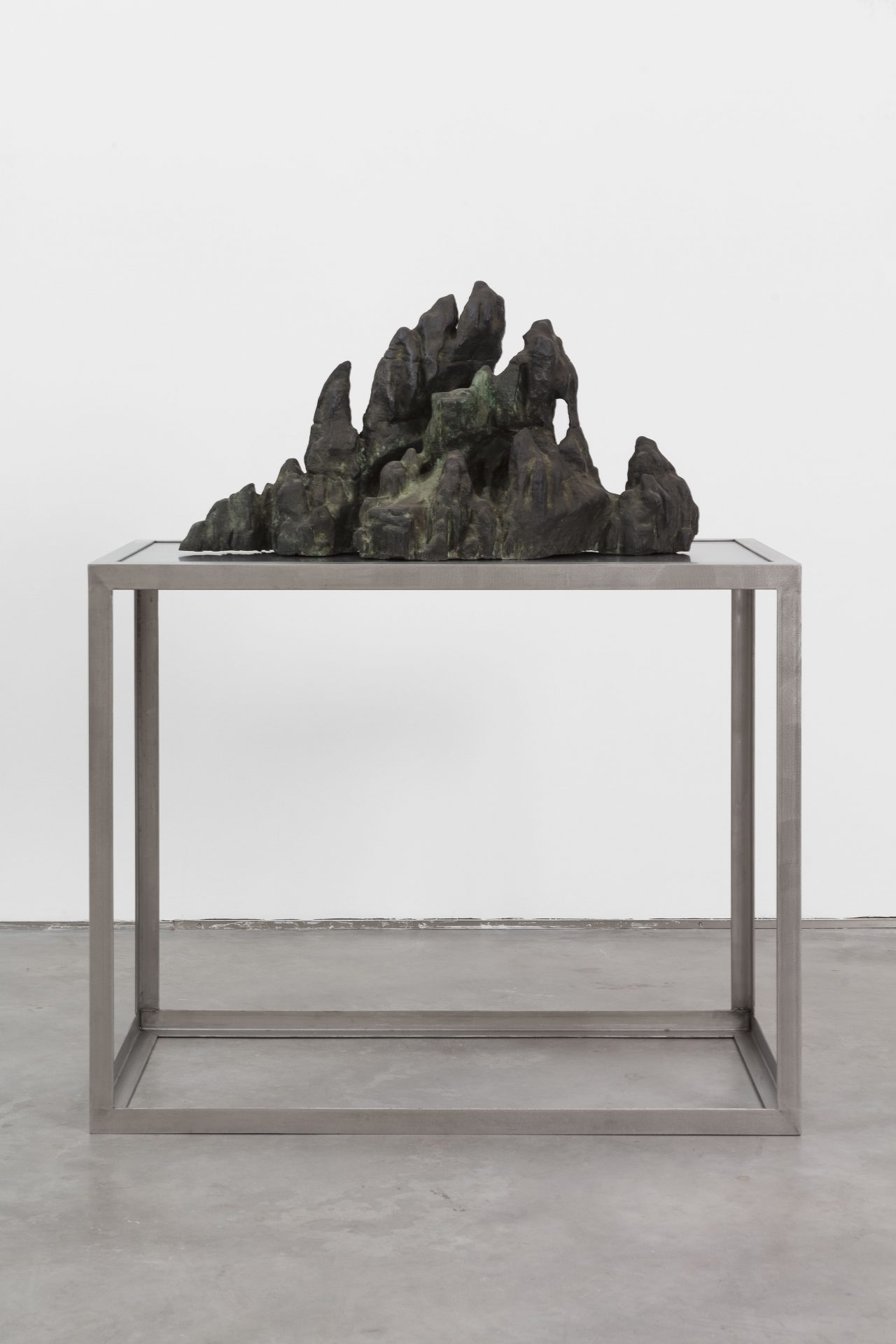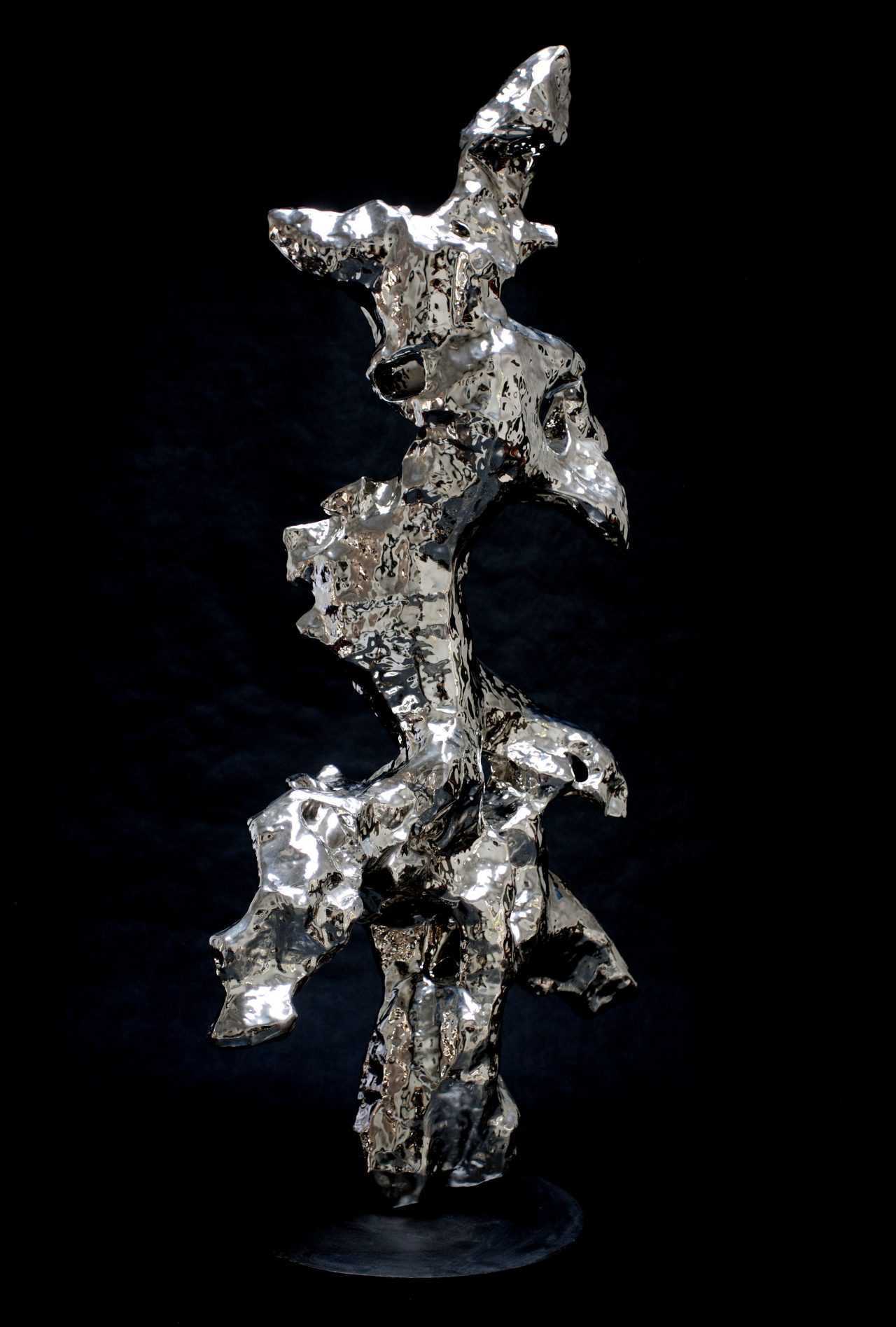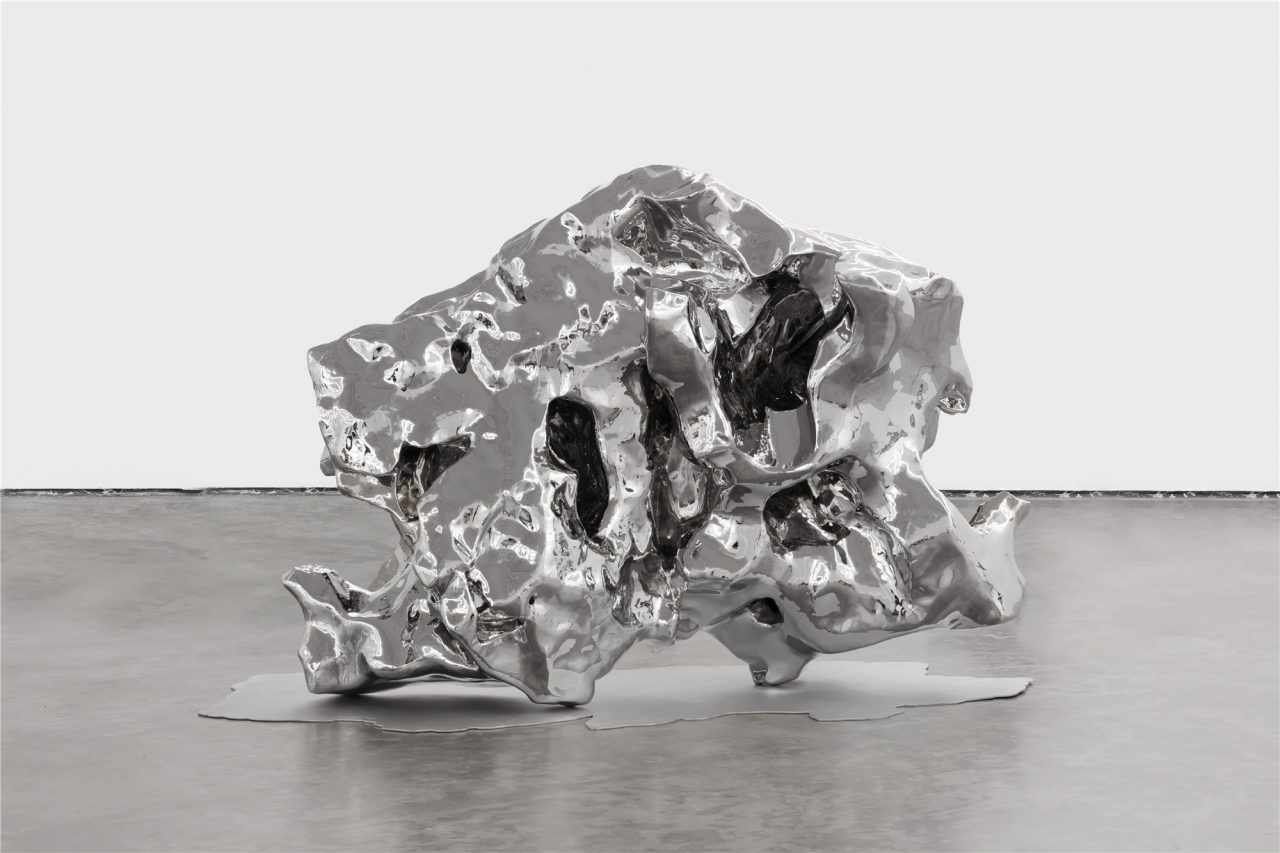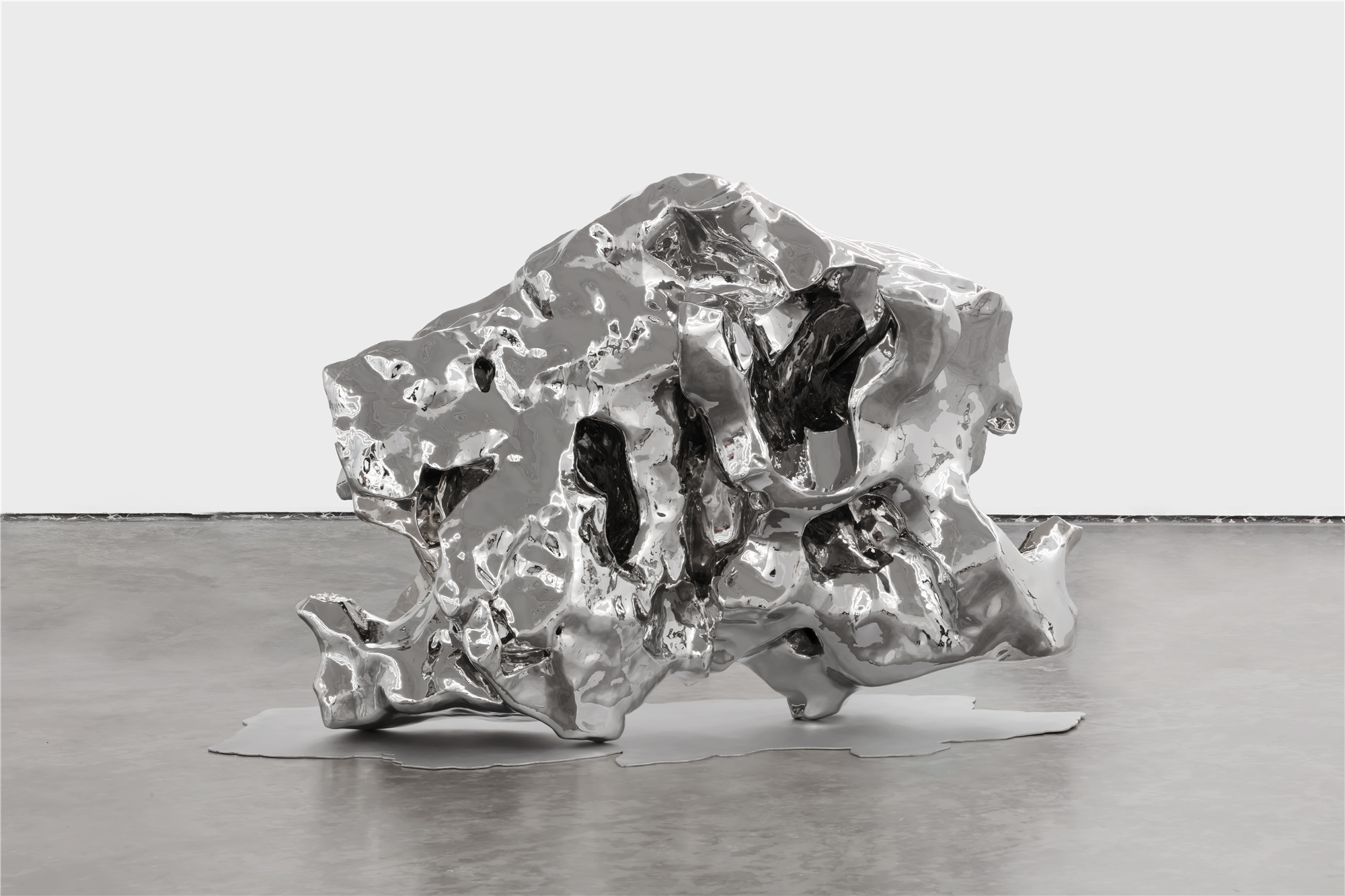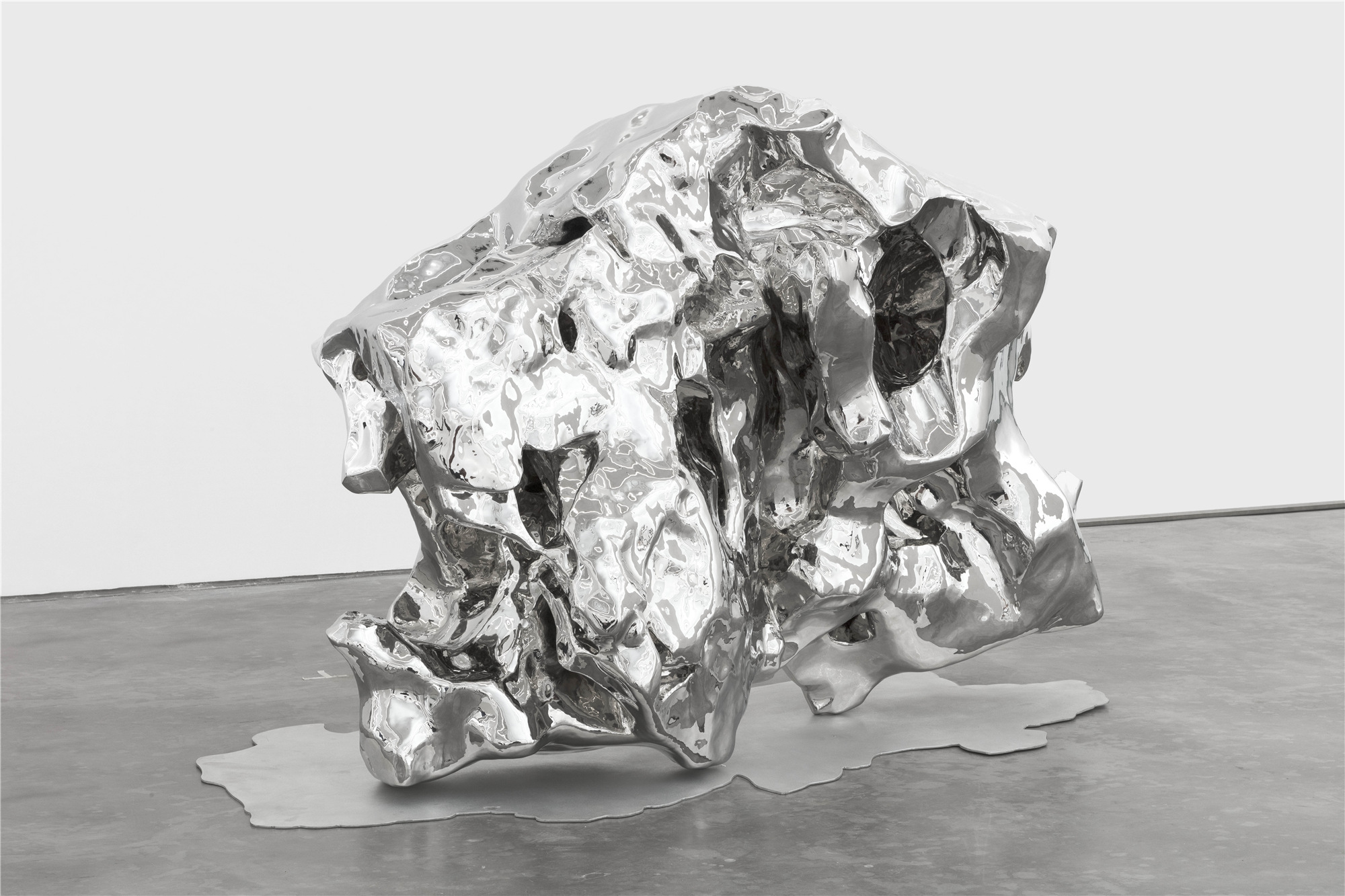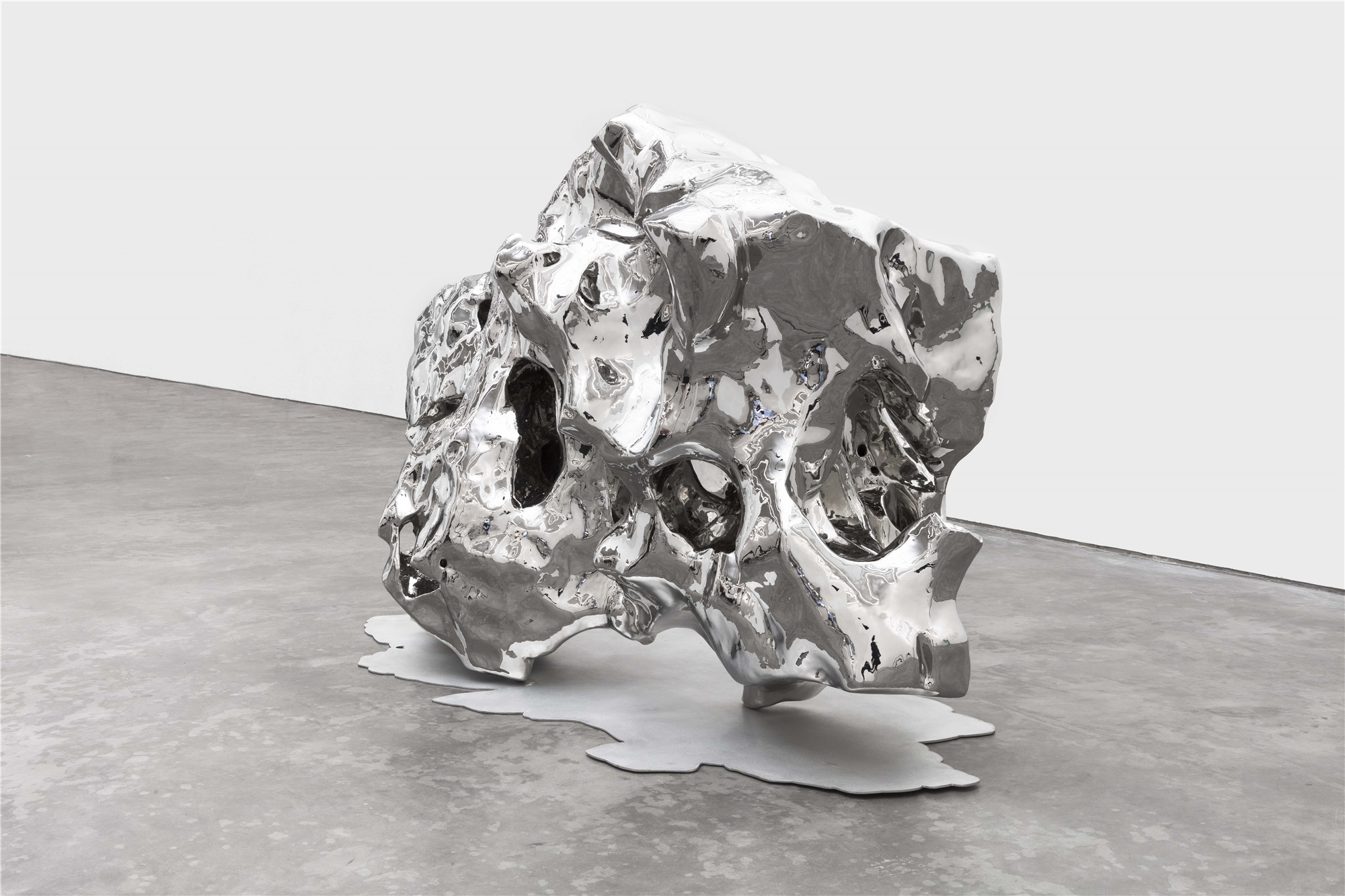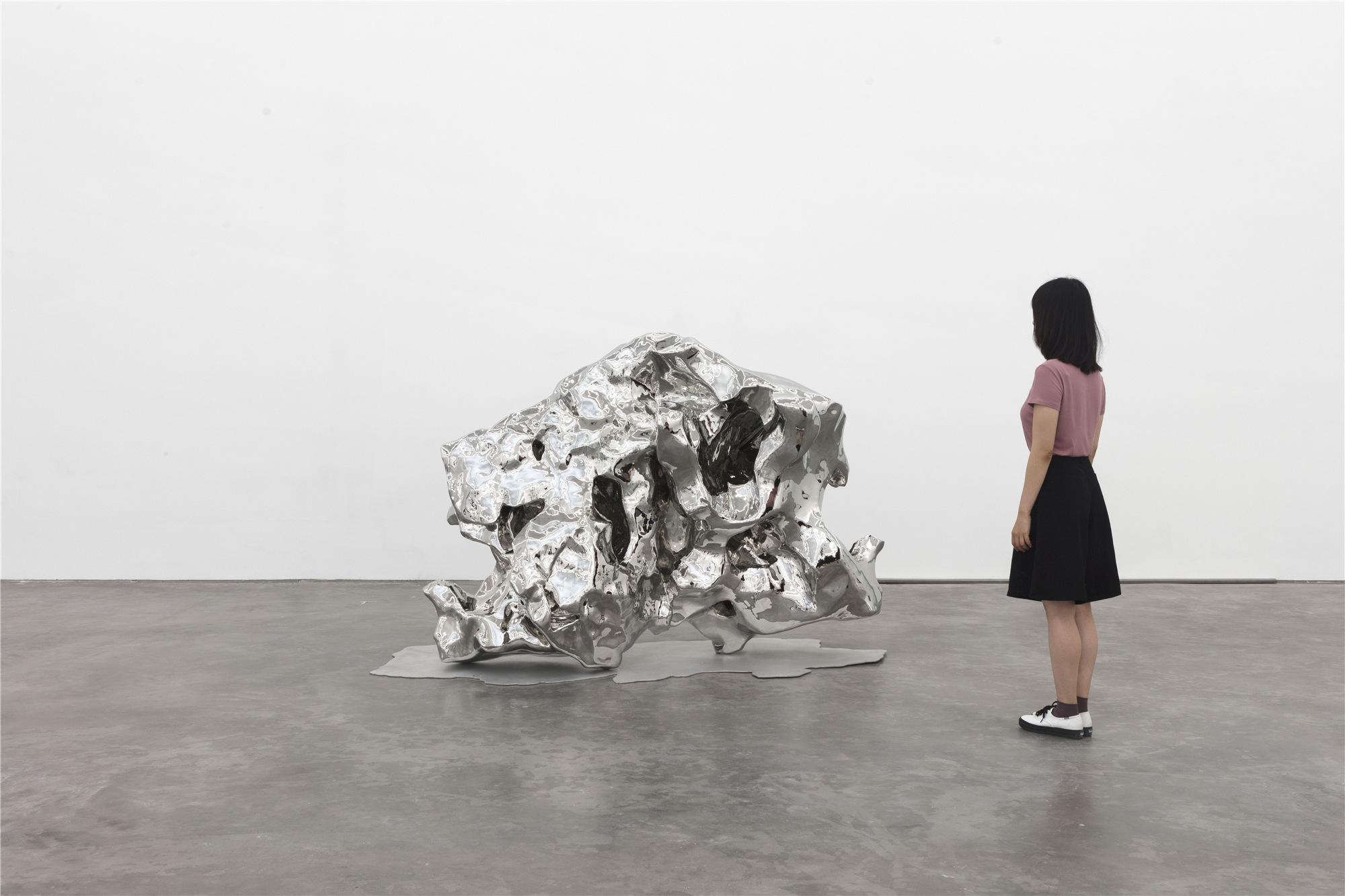展望:和石头有关的三个故事
从1995年第一块“假山石”,到正在长征空间个展“埃迪亚物”中的“非对称假山石”,展望“假山石”系列的创作已经有15年了,故事也刚好1001个;本期线上展厅将为大家讲述展望和石头有关的三个故事。线上展厅于北京时间2020年8月15日下午6时正式启动,开放至2020年8月21日下午12时。
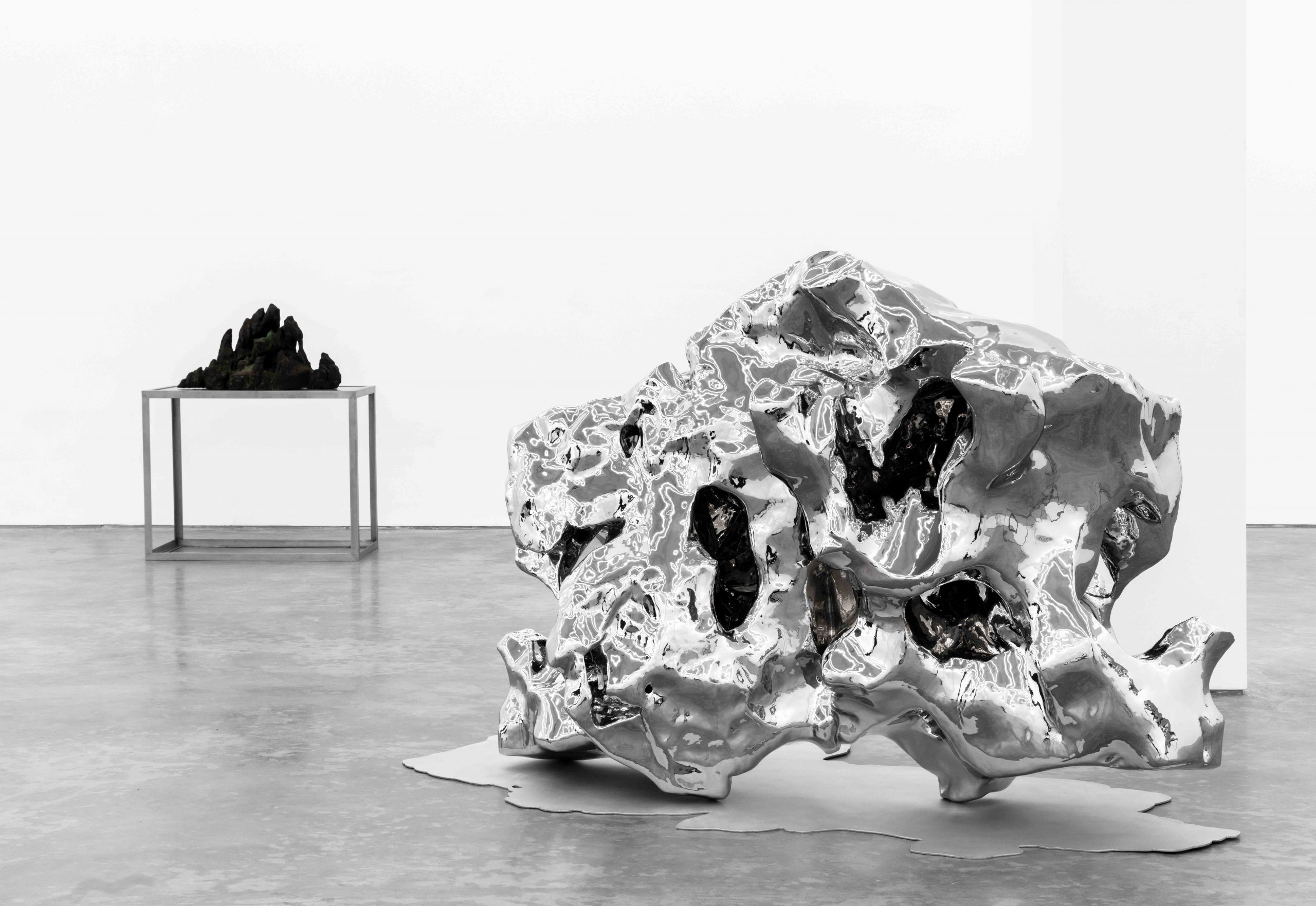
“在华丽的表面下被抽空的山石所隐现的假想即是我对今天真实生活的定义”
——展望, 1995
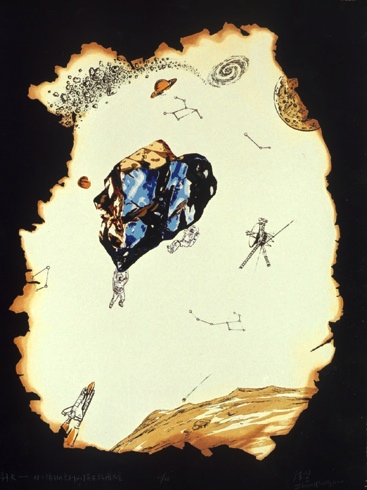
《新补天计划》草图,图片由展望艺术工作室提供
一、新补天计划
新补天计划早在一九九九年就开始了。一九九九年五月,我第一次到北京天文馆,希望复制在该馆收藏的明朝时期降落的铁陨石,遭到了婉拒,后来就做了第一次的“新补天计划”,当时叫“陨石计划”。第二年公海浮石计划完成之后,我第二次去天文馆。讲述了我实施的公海浮石计划。虽然还是不得其解,但是出于对我的信赖和同情,馆长最后同意我复制铁陨石,条件是再送给天文馆一个仿造的。二○○三年我携带这块复制的不锈钢陨石参加“长征——一个行走中的视觉展示”活动,奔赴西昌卫星发射中心。在卢杰和邱志杰两位策划人的协助下,与基地军官进行了讨论与交流,并达成以下协议:由卫星发射中心收藏这块不锈钢陨石,并在航天历史展的最后一个馆“航天展望馆”长期陈列,等待机会。
二○○三年十一月三十日中央美术学院举行“神舟”五号载人航天发射成功报告会。在美院书记杨力的帮助下,安排了与前来作报告的中国酒泉卫星发射中心原司令员刘明山将军,和中国卫星发射中心“九二一”工程指挥部林旭恒副主任的会面。我向他们讲解了我的“新补天计划”,并赠送了全套方案。他们听得非常有兴趣。最后林主任说:由于现在不能在太空中开窗,所以还无法把“陨石”送到太空里。看来,我们只是实现了“飞天”的梦想,但还不能实现“补天‘的梦想。二○○四年,不锈钢陨石的复制品被送到法国里昂参加中国当代艺术展——《道高一尺,魔高一丈》。
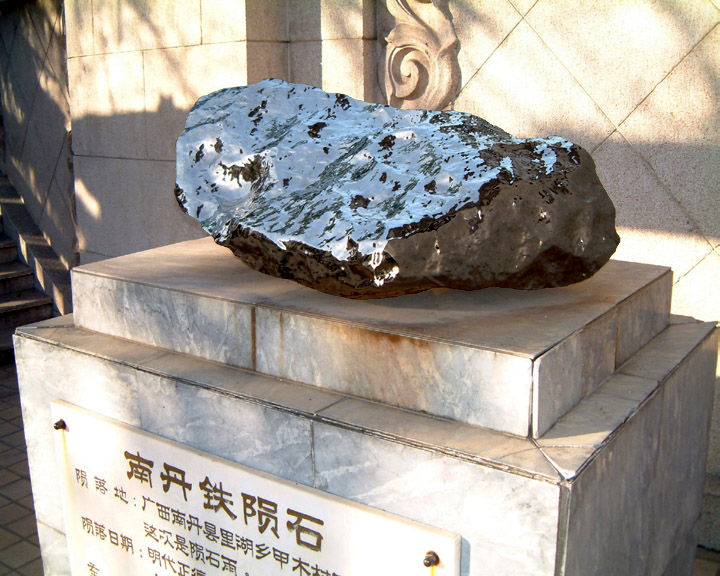
北京天文馆呈现展望明代陨石不锈钢翻制品,图片由展望艺术工作室提供
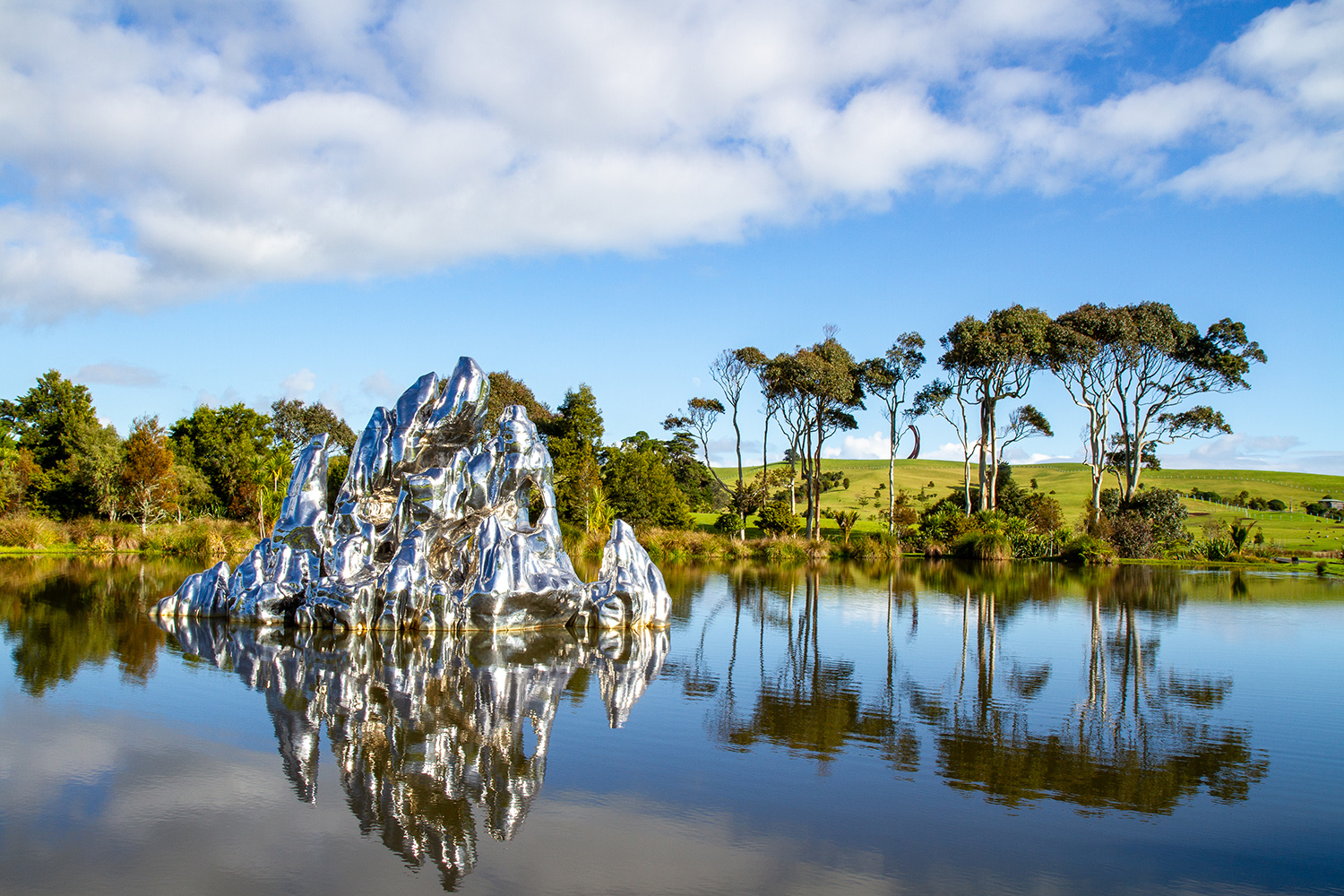
阿兰·吉布斯与珍妮·吉布斯夫妇收藏《漂浮的仙山》,呈现于新西兰凯帕拉港吉布斯农场,图片由 Alan Gibbs Farm 提供
二、漂浮的仙山
这个作品是为了参加比利时海上三年展定制的,这个展览将作品散布在奥斯坦丁(Ostand)这个城市的各个角落,包括PMMK当代美术馆的内部。虽然也是用不锈钢制造的“假山”,但与以往不同的是,用来拷贝的原石不再是购买原大的自然山石,而是把一个小石头改造成一坐大山。它的尺寸是:高8.6米,宽4.8米。“仙山”的造型汇聚了作者心中理想的“仙山”模样。制作方法仍然沿袭以前做石头的方法,不锈钢敲制,抛光,作成一坐闪亮的现代“仙山”。
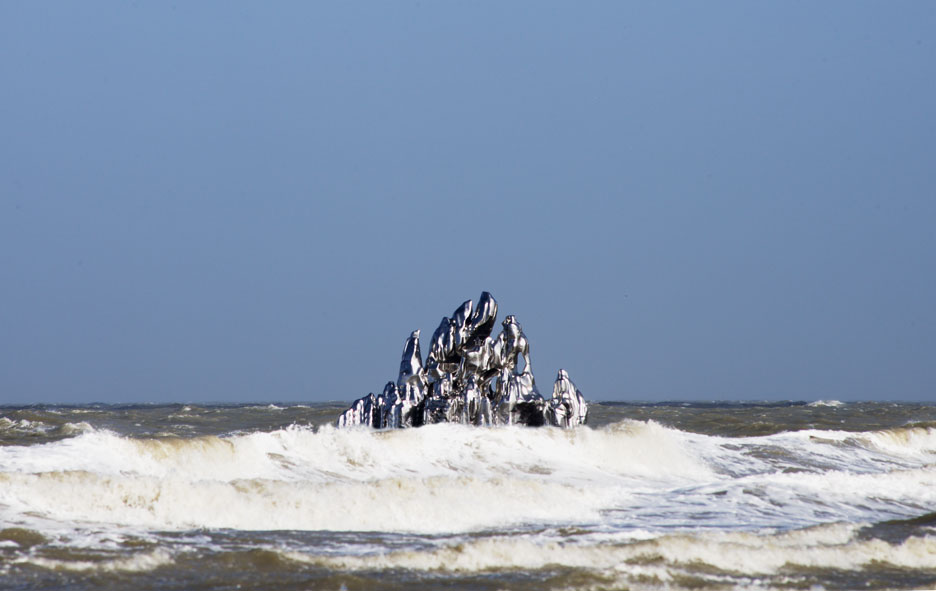
《漂浮的仙山》,2006,860 x 480 x 400 cm,奥斯坦丁泽布勒赫港远望,图片由展望艺术工作室提供
展出地点在比利时靠近荷兰的海岸,由一艘大船将作品沿海岸线拖到展出地点,在离海岸大约100米处抛下铁矛。那个浮船下面有两个矛固定在海底,当潮水上涨的时候,它会随着海的波浪起伏,整日漂浮在海面上,当落潮至最低点的时候,它可能就会完全暴露停靠在沙滩上。人们甚至可以“登山造访”。 这似乎是一个幻想的孤岛,一座从中国漂来的现代“仙山”,而生活在传统与现代衔接之间的人们,依然故我,似乎在漂浮不定中保持着某种自在状态;也不知道将要去那里,今天是欧洲,明天可能是世界上任何一个地方。从比利时海岸,这个古老的欧洲度假胜地来看,从遥远的中国漂来的人们似乎仍然相信自然的力量,但并不知晓他们的下一站将是哪里!
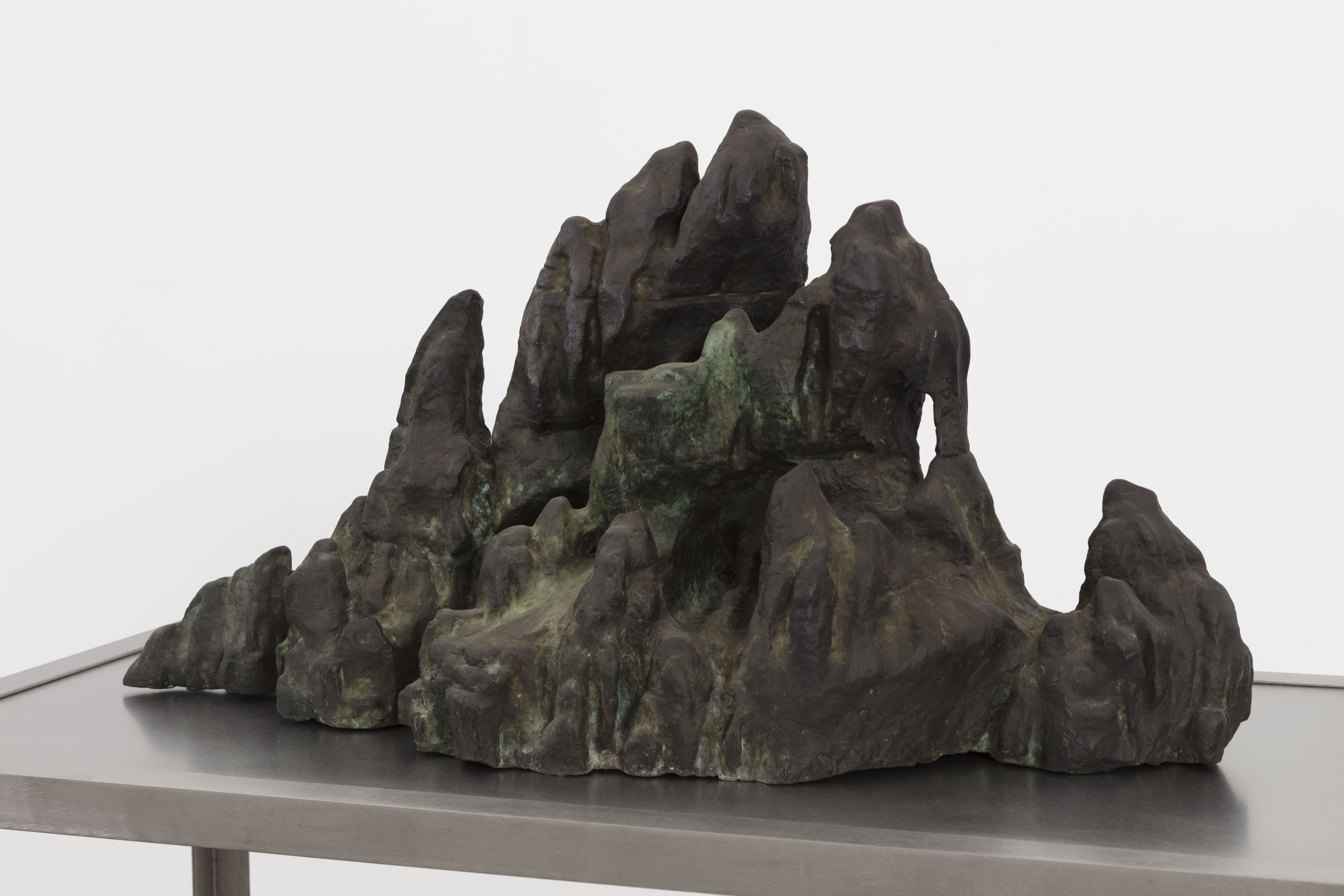
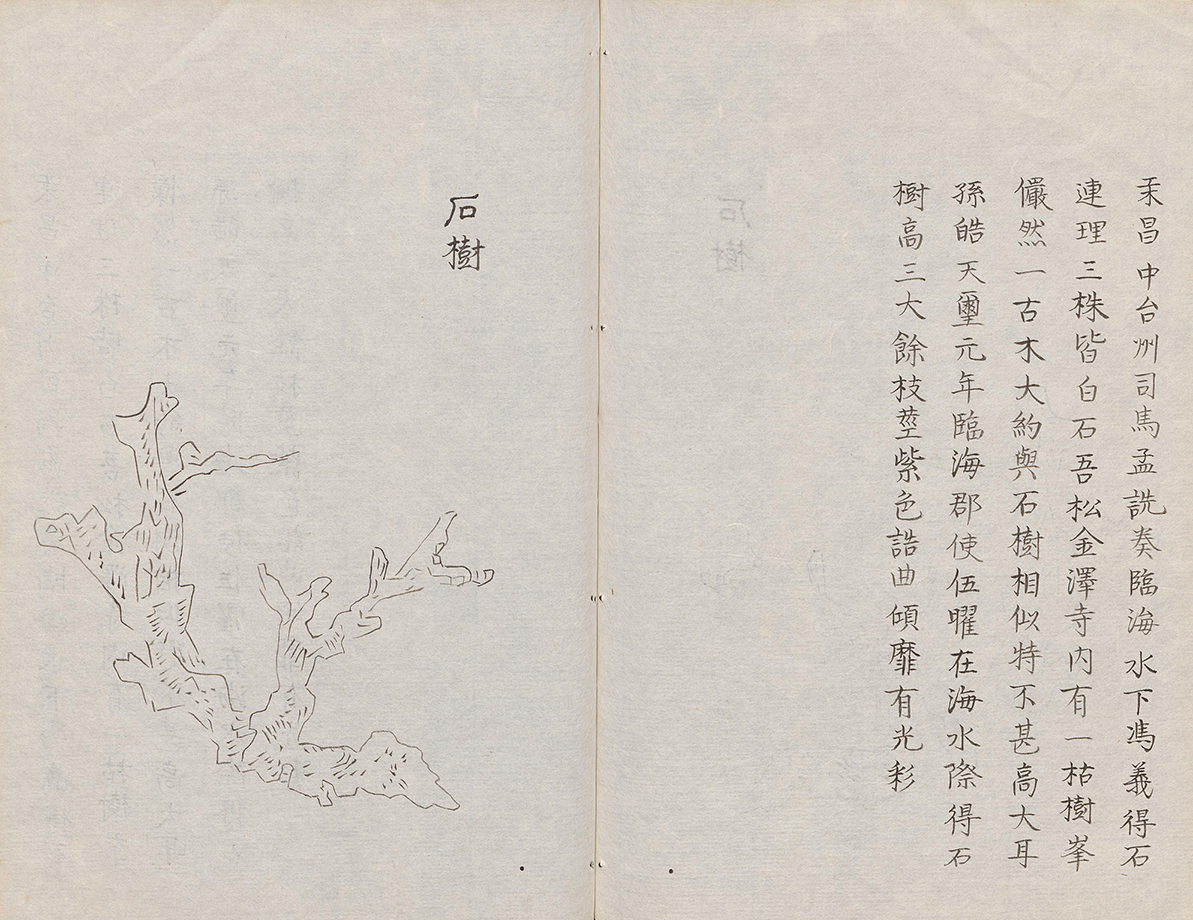
书籍《素园石谱》,图片来自网络
三、石树
石树,顾名思义,像树一样的石头,它不是指木变石(一种木头变的化石),而是一种经几亿年变化天然形成的。《素园石谱》中对这种石树也有记载。石头如何长成树的形状,其中究竟不得而知。但自然之力是可以创造任何你想不到的事物的,明明是石头,却是树的形状和趣味,但材质还是石头。这种类型假山石的艺术趣味就在于:什么不是什么。但自然也不是没有局限。把这种石头变成镜子,反射出金色或其它颜色,大概还是需要借人工之力和人工材料的。而最终出来的结果更是石头也不是石头,树也不是树,金属不是金属,几乎什么都不是,但看起来它又什么都是。似是而非,这真正是尽显似与不似的状态。
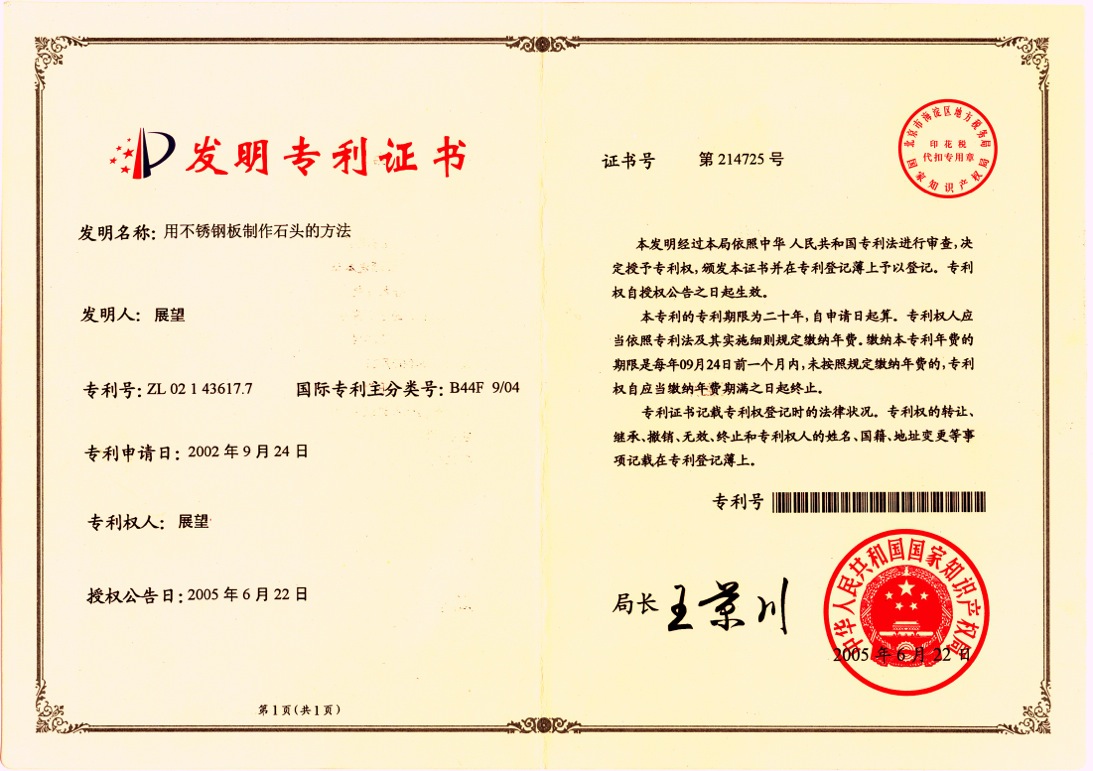
《用不锈钢板制作石头的方法》发明专利证书,图片由展望艺术工作室提供
不锈钢假山石的加工步骤
第一步:选石
被选的石头可以是自然界任何一块石头;
第二步:选材
选择高质量、耐腐蚀且厚度在0.8~1.5mm之间的不锈钢板材;
第三步:下料
沿石头的凸棱,将石头的整个表面划分成多个大块区域,然后用纸在石头上拓 出样板,再依样剪下覆在钢板上切割;
第四步:拓印
将裁好的不锈钢板覆在石头的相应区域上后,用锤子反复捶打,直至出现石头 的天然纹理;对于石头表面凹部较深的地方要拓印到位;
第五步:锤锻
对有些石头表面较平整的地方要做局部锻造处理,敲的时候下面要有垫铁;也 可以用全部锤锻的方法比较着石头敲出各部位的形状;
第六步:焊接
将锤锻完的不锈钢板块紧贴在石头上拼合,通过点焊进行固定,当剩下最后一 块不锈钢板时,把已经点焊成形的不锈钢壳从石头上取下,在所有点焊处进行 满焊;之后再把最后一块不锈钢板焊上,形成一个空壳石头;
第七步:打磨
对焊接和锤锻后的表面进行打磨,对于锤锻过的地方都要用砂纸片打磨,先用 粗砂纸,最后用特细砂纸;
第八步:抛光
用布轮手提抛光机在涂了蜡油的金属表面直接抛光,反复数遍,直到抛出镜 面。
----摘自《发明专利说明书》
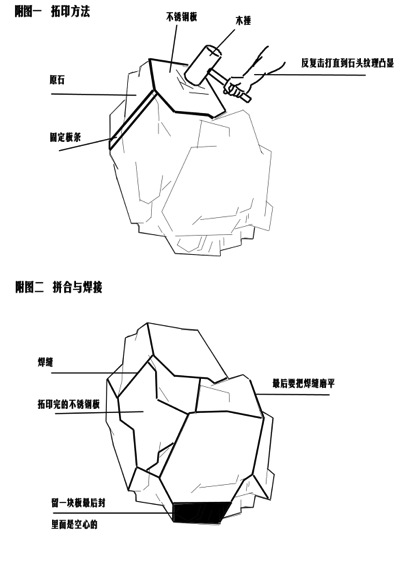
申请专利用的图示,图片由展望艺术工作室提供
中国人在造园中用真山石来堆积山景,民间称为“假山”。那么在新的建筑前面应该放 什么呢?于是假山就被拿来当雕塑了。我把这个现象作为一个思考的对象。一般来讲纯 自然才是“真”,而与此对应的人工世界为“假”。而当不锈钢拓印的假石头出现后, 真的显假,假的反而真,所谓“假作真时真亦假”。不锈钢是当代社会对合金技术的升 级发明,它可以使金属做到所谓“永不生锈”,这种不符合自然规律的愿望满足了现代 人的真实追求,而回归真实自然已成假想。这个逻辑上的矛盾交融在被抛成镜面的石头 反射中,可谓即人工又自然、既传统又现代。 “假山石”作品的造型遵循自然界没有一块石头是重复的定理,这是第一次把拓印的两块同一个石头反过来对接起来的试验,成为一块自然中不可能存在的石头,对等但不对称(非镜像关系),是对“假”的人工概念的进一步理解。
内容段落节选于展望所著《新素园石谱》,生活·读书·新知 三联书店,2008年
展望:和石头有关的三个故事
从1995年第一块“假山石”,到正在长征空间个展“埃迪亚物”中的“非对称假山石”,展望“假山石”系列的创作已经有15年了,故事也刚好1001个;本期线上展厅将为大家讲述展望和石头有关的三个故事。线上展厅于北京时间2020年8月15日下午6时正式启动,开放至2020年8月21日下午12时。

“在华丽的表面下被抽空的山石所隐现的假想即是我对今天真实生活的定义”
——展望, 1995
一、新补天计划

《新补天计划》草图,图片由展望艺术工作室提供
新补天计划早在一九九九年就开始了。一九九九年五月,我第一次到北京天文馆,希望复制在该馆收藏的明朝时期降落的铁陨石,遭到了婉拒,后来就做了第一次的“新补天计划”,当时叫“陨石计划”。第二年公海浮石计划完成之后,我第二次去天文馆。讲述了我实施的公海浮石计划。虽然还是不得其解,但是出于对我的信赖和同情,馆长最后同意我复制铁陨石,条件是再送给天文馆一个仿造的。二○○三年我携带这块复制的不锈钢陨石参加“长征——一个行走中的视觉展示”活动,奔赴西昌卫星发射中心。在卢杰和邱志杰两位策划人的协助下,与基地军官进行了讨论与交流,并达成以下协议:由卫星发射中心收藏这块不锈钢陨石,并在航天历史展的最后一个馆“航天展望馆”长期陈列,等待机会。

北京天文馆呈现展望明代陨石不锈钢翻制品,图片由展望艺术工作室提供
二○○三年十一月三十日中央美术学院举行“神舟”五号载人航天发射成功报告会。在美院书记杨力的帮助下,安排了与前来作报告的中国酒泉卫星发射中心原司令员刘明山将军,和中国卫星发射中心“九二一”工程指挥部林旭恒副主任的会面。我向他们讲解了我的“新补天计划”,并赠送了全套方案。他们听得非常有兴趣。最后林主任说:由于现在不能在太空中开窗,所以还无法把“陨石”送到太空里。看来,我们只是实现了“飞天”的梦想,但还不能实现“补天‘的梦想。二○○四年,不锈钢陨石的复制品被送到法国里昂参加中国当代艺术展——《道高一尺,魔高一丈》。
二、漂浮的仙山

阿兰·吉布斯与珍妮·吉布斯夫妇收藏《漂浮的仙山》,呈现于新西兰凯帕拉港吉布斯农场,图片由 Alan Gibbs Farm 提供
这个作品是为了参加比利时海上三年展定制的,这个展览将作品散布在奥斯坦丁(Ostand)这个城市的各个角落,包括PMMK当代美术馆的内部。虽然也是用不锈钢制造的“假山”,但与以往不同的是,用来拷贝的原石不再是购买原大的自然山石,而是把一个小石头改造成一坐大山。它的尺寸是:高8.6米,宽4.8米。“仙山”的造型汇聚了作者心中理想的“仙山”模样。制作方法仍然沿袭以前做石头的方法,不锈钢敲制,抛光,作成一坐闪亮的现代“仙山”。

《漂浮的仙山》,2006,860 x 480 x 400 cm,奥斯坦丁泽布勒赫港远望,图片由展望艺术工作室提供
展出地点在比利时靠近荷兰的海岸,由一艘大船将作品沿海岸线拖到展出地点,在离海岸大约100米处抛下铁矛。那个浮船下面有两个矛固定在海底,当潮水上涨的时候,它会随着海的波浪起伏,整日漂浮在海面上,当落潮至最低点的时候,它可能就会完全暴露停靠在沙滩上。人们甚至可以“登山造访”。 这似乎是一个幻想的孤岛,一座从中国漂来的现代“仙山”,而生活在传统与现代衔接之间的人们,依然故我,似乎在漂浮不定中保持着某种自在状态;也不知道将要去那里,今天是欧洲,明天可能是世界上任何一个地方。从比利时海岸,这个古老的欧洲度假胜地来看,从遥远的中国漂来的人们似乎仍然相信自然的力量,但并不知晓他们的下一站将是哪里!

三、石树

书籍《素园石谱》,图片来自网络
石树,顾名思义,像树一样的石头,它不是指木变石(一种木头变的化石)。而是一种经几亿年变化天然形成的。《素园石谱》中对这种石树也有记载。石头如何长成树的形状,其中究竟不得而知。但自然之力是可以创造任何你想不到的事物的,明明是石头,却是树的形状和趣味,但材质还是石头。这种类型假山石的艺术趣味就在于:什么不是什么。但自然也不是没有局限。把这种石头变成镜子,反射出金色或其它颜色,大概还是需要借人工之力和人工材料的。而最终出来的结果更是石头也不是石头,树也不是树,金属不是金属,几乎什么都不是,但看起来它又什么都是。似是而非,这真正是尽显似与不似的状态。
不锈钢假山石的加工步骤
第一步:选石
被选的石头可以是自然界任何一块石头;
第二步:选材
选择高质量、耐腐蚀且厚度在0.8~1.5mm之间的不锈钢板材;
第三步:下料
沿石头的凸棱,将石头的整个表面划分成多个大块区域,然后用纸在石头上拓 出样板,再依样剪下覆在钢板上切割;

申请专利用的图示,图片由展望艺术工作室提供
第四步:拓印
将裁好的不锈钢板覆在石头的相应区域上后,用锤子反复捶打,直至出现石头 的天然纹理;对于石头表面凹部较深的地方要拓印到位;
第五步:锤锻
对有些石头表面较平整的地方要做局部锻造处理,敲的时候下面要有垫铁;也 可以用全部锤锻的方法比较着石头敲出各部位的形状;
第六步:焊接
将锤锻完的不锈钢板块紧贴在石头上拼合,通过点焊进行固定,当剩下最后一 块不锈钢板时,把已经点焊成形的不锈钢壳从石头上取下,在所有点焊处进行 满焊;之后再把最后一块不锈钢板焊上,形成一个空壳石头;

《用不锈钢板制作石头的方法》发明专利证书,图片由展望艺术工作室提供
第七步:打磨
对焊接和锤锻后的表面进行打磨,对于锤锻过的地方都要用砂纸片打磨,先用 粗砂纸,最后用特细砂纸;
第八步:抛光
用布轮手提抛光机在涂了蜡油的金属表面直接抛光,反复数遍,直到抛出镜面。
----摘自《发明专利说明书》
中国人在造园中用真山石来堆积山景,民间称为“假山”。那么在新的建筑前面应该放 什么呢?于是假山就被拿来当雕塑了。我把这个现象作为一个思考的对象。一般来讲纯 自然才是“真”,而与此对应的人工世界为“假”。而当不锈钢拓印的假石头出现后, 真的显假,假的反而真,所谓“假作真时真亦假”。不锈钢是当代社会对合金技术的升 级发明,它可以使金属做到所谓“永不生锈”,这种不符合自然规律的愿望满足了现代 人的真实追求,而回归真实自然已成假想。这个逻辑上的矛盾交融在被抛成镜面的石头 反射中,可谓即人工又自然、既传统又现代。
“假山石”作品的造型遵循自然界没有一块石头是重复的定理,这是第一次把拓印的两块同一个石头反过来对接起来的试验,成为一块自然中不可能存在的石头,对等但不对称(非镜像关系),是对“假”的人工概念的进一步理解。
内容段落节选于展望所著《新素园石谱》,生活·读书·新知 三联书店,2008年

